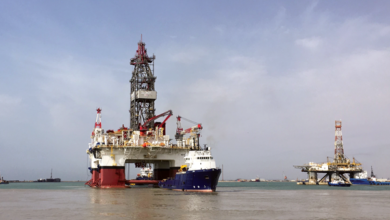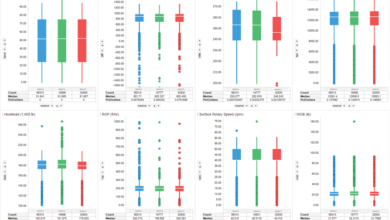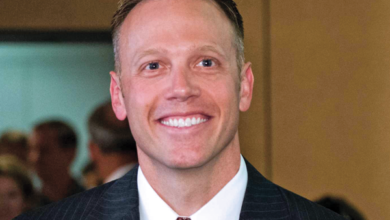Amid continued rig oversupply, Transocean leverages data to drive pragmatic rig retirement decisions
Data-driven approaches also being used to guide reliability-centered maintenance and develop performance dashboards for reducing flat spots
By Linda Hsieh, Managing Editor
Jeremy Thigpen is President and CEO of Transocean.

Looking at the offshore and deepwater and ultra-deepwater market, what do you see as the most critical challenges right now?
The No. 1 challenge that we face today is making the deepwater and ultra-deepwater market economically viable through the cycles. To be clear, this is not just a challenge for drilling contractors. Everyone across the value chain must work together to find ways to become more efficient, such that we can all generate sufficient returns should oil prices remain below $60/bbl.
What efforts have you seen the industry make over the past couple of years to achieve such efficiency?
More than anything else, I have been encouraged by the fact that across the spectrum, each industry participant is recognizing this collective challenge to drive efficiencies through the value chain. While our customers, the operators, are certainly pressuring us to reduce costs, they are also changing the way that they’re conducting business. They’re streamlining their organizations and redesigning their processes. They’re also seeking input from drilling contractors and other service providers to identify opportunities for us to jointly eliminate waste and cost from the system.
The question now is how much more efficient can we get? How much lower can those break-evens become and are they sustainable? I have asked our customers: Of the dramatic reduction that we have seen in cost per barrel, how much is discount and dayrate-based, and how much is sustainable, meaningful core change? Almost every company has suggested that the split is roughly 50/50.
So, of the cost reductions that we have realized to date, it would appear that 50% is structural and should stick. The other 50% will fluctuate as both oil prices and demand for assets and services tick up.
Where else in the well construction process do you see opportunities for more efficiency improvements beyond what we’ve already done?

I believe that we can better utilize data to continue to improve our drilling performance. At Transocean, we have three times the ultra-deepwater experience of our next nearest competitor. With that, we have accumulated a considerable amount of data in every major global offshore operating environment. We’ve used this data a bit in the past but not to its full potential. Today, we’re taking all of that past history and creating what we call performance dashboards so we can look at every phase of the drilling program to determine how we can both optimize and standardize our performance across our entire fleet. At this point, our primary focus is on reducing, if not eliminating, the frequency and duration of any flat spots.
How are these performance dashboards being used?
First, by simply measuring and visually displaying our performance when executing critical processes, we expect to see the improvement that is typically generated through healthy competition. Second, by comparing real-time performance data from crew to crew and rig to rig, we expect to be able to quickly identify outliers, both outperformers and underperformers. This will enable us to quickly identify best practices and spread them across the fleet and to quickly identify and provide support to those crews and rigs where we may identify performance improvement opportunities.

In addition to driving competition, identifying best practices and addressing outliers, the dashboards will enable us to more clearly focus on streamlining key processes. Today, our number one area of focus is tripping. We spend more time tripping than we do drilling. So, what can we do to compress that time frame? In addition to tripping, we are working closely with the other service providers to better coordinate transitional activities and with the OEMs to better plan and execute the maintenance of our critical equipment.
There has to be thoughtful planning around critical components, so we are aligning around desired outcomes with OEMs and other service providers. For us, uptime and cost are critical. If I’m at 98% uptime with a piece of equipment, then how do I get to 99% uptime? If it costs me X, then how can I get .9X? We’re in some very healthy conversations with the OEMs, and I’m confident that we will collectively find a way to create value in the near future. We’re also talking with large integrated service companies to find ways to deliver more cost-effective and efficient solutions, particularly in deepwater and ultra-deepwater. Operators can help with this, as well. Having a bespoke solution on every well creates incremental costs. A more standardized approach that is consistent and repeatable may produce better safety, efficiency and cost results across the value chain.
With the increasing adoption of reliability-centered maintenance and innovations like the performance dashboards you mentioned, it seems like data will be the foundation for driving efficiency?

Data is the enabler. Ultimately, the manner in which we use the data will drive the efficiency. The data is important in that it gives us additional information to make more informed decisions based on actual historical and current performance. Since we have already talked about the performance dashboards and their role in driving efficiency, let’s talk about reliability-centered maintenance.
A piece of equipment on Rig A is not operated under the same conditions as an identical piece of equipment on Rig B. Therefore, why should we utilize a calendar-based maintenance program? By capturing data to monitor the actual wear on a piece of equipment, we can better determine when and how each distinct piece of equipment should be maintained and serviced. Through this approach, we will optimize the maintenance process, while simultaneously reducing risk.
Is enough data being collected on the rig at this point?
It’s not the amount of data. It’s selecting the right data. We have to narrow down what data is meaningful and can drive performance improvement. That’s what we’ve been working on. Once we have data that’s important to our OIMs or rig managers or senior mechanics, we can put that performance dashboard in front of them, and use the information to make informed and timely decisions.
What efforts have you seen the industry make on increasing collaboration as a way to drive more efficiency?
I’ll give you an example. A customer recently led a team meeting ahead of a campaign that brought together all critical personnel. This meeting ahead of the campaign initiated the team approach and gave us a chance to discuss the challenges that could be faced, the project’s metrics and its desired outcomes. We are witnessing a more collaborative approach across the offshore space as we recognize offshore must be more economically viable at lower prices. As painful as this downturn has been, it has forced us to do some things that we should have done years ago in terms of streamlining and focusing on efficiency and closer collaboration.
How has Transocean approached rig retirements during this downturn? We know that more rig retirements are needed to bring the supply/demand picture back into balance.
First, I think there’s a misperception that the age of the rig determines its value. Some rigs with older hulls have been completely upgraded and have the technical capability of newer rigs. Rigs also have been operated and maintained differently and in different environments, all of which impact the future marketability and value of the rig. In short, there are some older rigs that are still highly competitive.
With that said, we have taken a pragmatic and data-driven approach to our fleet. First, we forced ranked every single rig in the world, including the rigs that are under construction. We looked at the technical specifications of each rig, and we put a weight to each metric. Age was one of the metrics, but it was not weighted as heavily as technical specifications.
Then we looked at potential rig demand. In a more normalized environment, how many floaters do we think the industry will need over the next few years? That’s where we drew the line, and we recognized that all rigs below that line likely need to be removed. So for all Transocean rigs below that line, we decided that when they rolled off contract, we would retire them. We’re not going to waste a dollar stacking them.
There are a few exceptions in certain regions of the world, but mostly that’s what you’ve seen from us over the course of the past two years. Unfortunately, following this approach, we have retired 29 assets that previously created significant value for our customers and our company. But, going forward, we just don’t think they’re going to meet the technical specifications required to be marketable.
During the next 12 to 18 months, I think you’ll see far more rig retirements in the industry. Customers will show clear preference for the more technically capable rigs, and that will ultimately force more rigs into retirement.
Since we are talking about our customers’ preference for more technically capable rigs, I would like to mention that we have welcomed three new state-of-the-art, ultra-deepwater drillships to our fleet that are tied to long-term contracts. We also have two more rigs that are currently under construction, both tied to 10-year contracts, and two more under construction without contracts. In our forced ranking of high-specification assets, these seven rigs are positioned right at the top, so we are excited about that. We recognize even in a downturn, we have to invest in our future.
How are you working to reduce your rig stacking costs?
First of all, we don’t warm-stack rigs. When a rig rolls off contract, we know if we have any meaningful near-term opportunities. If we have two or three opportunities, we’ll keep the rig hot. But if there are no realistic opportunities, we immediately scrap it if it’s below the line that we drew. If it’s above the line, we immediately go to cold-stack, where we are preserving the equipment by sealing it up – air tight. We have dehumidification units on the rig powered by generators and are keeping all of the controls completely dry. We air-condition the accommodations to make sure there is no mold or mildew and everything is kept in good working order.
We currently have multiple rigs in Trinidad in a cluster stack, which are overseen by a skeleton crew. As a result of these efforts, our stacking costs are down significantly, and we’re confident that these rigs can be cranked up with minimum effort.
Of note, in 2016 we secured work for two cold-stacked rigs that we reactivated at a time when hot-stacked rigs were readily available. To me, this demonstrates our customers’ confidence in our equipment preservation and our ability to reactivate the assets on time and on budget.
What innovations do you expect from this downturn?
People hear the word innovation and they often think technology. I don’t think that’s the case this cycle. Instead, innovation is going to occur through new business and commercial models and revamped processes. For example, we’re entering into commercial agreements where we are assuming some risk by accepting lower than our typical expectation on dayrate, but then layering in performance bonuses based on our ability to outperform the customer’s budget.
And so far, customers have really liked this model because it’s self-funding and it aligns our interests. I believe it helped us to win a higher percentage of the few contracts that were out there in 2016.
Other innovations may come by changing business relationships with service providers or OEMs, and using data to drive drilling efficiency and improve uptime. That’s where the real innovation is taking place.
What are the challenges to sustaining that type of performance-based contract model in the long term?
The challenge may be with the customer constantly trying to raise the bar. If you delivered the last well in 28 days, the customer may want to set the new bar at 25 days. While I’m fully supportive of continuous improvement, at some point, if the customer raises the bar to the point that the bonus opportunity is no longer sufficiently meaningful, then the model will no longer work, and you will see the industry revert to a higher dayrate with limited to no performance bonus. Ultimately, it is going to be driven by the customer. If the customer values this model, then we’ll find a way to deliver it. It is not going to be the same for all customers – some customers may prefer a fixed dayrate.
What is the next frontier for our industry as far as trying to reach zero incidents?
There is still a lot to do even as we have improved as an industry and as an organization. We have seen a step-change in safety, but until we are not hurting anybody, we are not there. At Transocean, we’ve focused on procedural discipline and how to make our procedures simpler, more straightforward, more obvious and more consistent across our fleet. We pulled together our top people on the rigs and walked through each procedure, so that we could streamline them, identify best practices and make them more intuitive and visually appealing. We are now implementing these new procedures across our fleet.
Process safety is another important area where we, as an industry and as a company, have continued to improve. In our approach to process safety, we’ve identified five things that can potentially be catastrophic: fires, floods, station keeping, well control and big dropped objects. And, in an attempt to avoid any of those five things from happening, we continue to build in and test multiple layers of hard barriers. We also continue to update our procedures and stress the importance of procedural discipline. And we continue to diligently educate our rig personnel to make sure everyone understands the risks and how to mitigate them, the procedures and the barriers.
The next step for the industry is in understanding how people think as they’re performing their jobs. We must find ways to ensure our employees remain focused at all times and have the right frame of mind.
There’s still more to do, but I think ongoing safety efforts like these and training will continue to push the industry in the right direction toward zero incidents. DC




